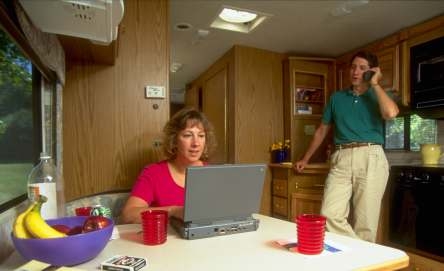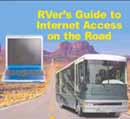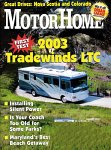Giving
up a foundation house for one with wheels, a motorhome, travel
trailer or fifth
wheel, generally means giving up easy reliable internet
access. But RVers have several ways to
get connected. Wi-Fi, cellular phones and two-way
satellite even make it easy.

 RVers
Guide to Internet Access On The Road RVers
Guide to Internet Access On The Road
New ebook explains
the many options — dial up, cell phones, WiFi, Pocketmail, satellite,
etc.
LEARN
MORE
|
For
most of us it’s a matter of getting internet access
wherever and however we can. Fortunately, RVers are are a resourceful
group and have found creative ways to get access.
Many
RV parks have phone lines at each site but usually you
have to make
arrangements directly with the phone company to have
it turned on and the connection fees make it hard to justify
unless you plan to stay at least a month.
It’s
rare to find a park with hot phone lines at each site
but it’s nice when you do. A hot phone allows you
to drive in to your site and instantly have phone service. The
service is almost always restricted to local and toll-fee calls
so any long distance call you want to make will require a calling
card.
These
hot phones are great for internet access if there is a
local dial-up number for your ISP. If your ISP
has an 800 number,
for times when there is no local number, then you’re all
set.
But
usually, getting internet access means borrowing a phone
line. For most of us a daily trip to the ‘modem hookup’ is
routine.
Now days most commercial RV parks (but not too many government
campgrounds) have a modem hookup. Usually it’s in the
office but sometimes you’ll find it in the activity room
or elsewhere. These lines are also restricted to local of 800
number service and the management will often ask that you limit
your time.
It's
generally good manners to download your mail, disconnect
and leave to read and answered your mail off-line
back at your RV. Unless you have important email you can
wait until the next day to return to the modem station.
This time
your will upload your outgoing mail and as well as download
new mail.
Other
sources for hookups are family and friends you may be visiting,
internet cafes, libraries and truck stops.
Since
you have to take your computer to these places a laptop
is almost a
necessity.
Cell Phone
Many RVers have been using their cell phones for internet
access for some time now but recently it’s gotten easier and much
more affordable. Most cell providers have some sort of internet
access but Sprint PCS seems to have the advantage right now in
both digital coverage area and cost. Sprint’s access speed
is faster than that of other suppliers.
Fran
and I use Verizon Wireless and connect to their Quick 2 Net digital
network at 14.4kbps. When available we use Verizon's faster National Access which is closer to normal dial-up speed. Use of either network is only charged
against our regular calling minutes. Since we have 3,000
night and
weekend minutes we can get our email and do our online
banking virtually
for free as long as we do it during off-peak times.
Recently
Sprint began offering unlimited access to it’s
high speed digital network for $10 additional to whatever monthly
plan you have. Verizon has a fast network similar to Sprint but
charges considerably more to use it so we opted not to.
As
I understand it Sprint's service agreement only allows
the use of the features that are part of the phone. You
cannot
attach any device to the phone which of course includes a
computer.
There
is controversy though from RVers who say they are in fact
using their computers attached to the phone
to get internet
access. Furthermore,
they claim that 'someone' at Sprint said it was okay.
My
guess is that if you 'fly under the
radar' you can get away with it. But then, other RVers
say they or 'a friend' have been hit with huge bills
from Sprint
because they were using the data network with a computer.
I'll
be sticking with Verizon for the time being even if
it is slow. But anytime Sprint or another provider offers
'real' internet access a tan affordable price I'll switch.
Connection
kits for many cell phones are available at cellular phone
stores but you should know
if one is available for the
the phone you plan to buy before you buy the kit or the phone.
Most any PC laptop will work with the connection kits available
but you may want to make sure.
If
you use a Macintosh your options are more limited but if
you are running OS X you can still use it... we
do. For Mac solutions
see SmithMicro.com.
All
this bodes well for RVers, at least those who stay in areas
where the digital
networks are available. Wi-Fi
Wi-Fi
If
you haven’t heard about Wi-Fi you soon will. Wi-Fi
stands for Wireless
Fidelity. It’s also know as 802.11and we Mac users call it AirPort. Whatever
you call it Wi-Fi is basically a two-way radio with about a 300 ft. range and
software that sends and receives standard internet data.
Right
now Wi-Fi usually takes the form of a $50 - $100 PC card
that plugs into
your PC’s PCMCIA slot. But Intel has been in the news lately announcing
it will include the technology in it’s new laptops. It has been built into
Macintosh laptops for several years now by way of an optional internal card.
Places
where internet access is provided by Wi-Fi are often called
hotspots and hotspots are being set up in tens of thousands
of new places this year. Restaurants,
coffee shops, convenience stores, hotels, motels, airports, even truck stops.
Just about anyplace where people congregate is likely to have a hotspot in
the
next few years.
There
are several pay-for-service hotspot providers and the businesses
who host them either find it easier than operating a hotspot
themselves or consider it a profit center since the host
usually gets a percentage of the income.
Starbucks
Coffee Shops made headlines when it announced that hotspot
provider T-Mobile would have hotspots
in nearly all of it’s shops by the end of
the year. Most of them are already up and running. Even McDonalds restaurants
announced it has a market test ongoing in New York right now. Get
an hour of
free access when you buy a Value Meal.
Most
of these place charge for access and rates vary a lot depending
on the provider. They have Pay-As-You-Go as well as
subscription plans. Visit: http://www.t-mobile.com/hotspot/ and http://www.wayport.com/ to
get an idea of where to look for hotspots and what they cost. Some provides,
like Boingo, ( http://www.boingo.com )
require special software. But I've not used it so I cannot comment.
As
I said, the fees of each pay-for-service hotspot provider
vary widely but experts think fees
will
even
out in the next year or two while becoming more
affordable. Many providers are working now to share each
other's networks so that
subscribers
can use hotspots without worrying about who it belongs
to.
Besides pay-for-service
you can also find free access. Free hotspots are
often offered by public agencies... libraries, schools,
parks,
etc. In
many
areas,
users themselves are working together to provide free hotspots to the community.
Free hotspots are also offered by businesses that feel the service sets them
apart from their competition and attracts customers.
Some
hotspots are
at residences. Sometimes they are left open intentionally
to share access with neighbors but usually it's because
homeowners simply
are not
unaware of security
issues.
It's
the free hotspots that we look for. We find them
with 'sniffer' software while driving around town. I drive
and Fran watches the computer. When the computer finds
a hotspot we find a parking place nearby. Sometimes the networks
are not connected to the internet, but we usually find
an open access point we can use.
Since
we only use the open network for internet access and
do not try to 'hack' their system we don't feel we are
doing anything wrong.
Of
special interest to RVers is that many RV parks are looking
at Wi-Fi as a less expensive alternative to hot phones
since many of us just want the phone line for internet
access anyway. As with other hotspots some parks will charge
and others will offer wi-fi for free.
Wireless
is good but Wi-Fi is also fast. About the same speed as
DSL or broadband cable. The combination is making Wi-Fi
especially popular with mobile computer users.
There is more than one Wi-Fi standard. Two standards
are fighting for dominance... ‘a’ and ‘g’.
The ‘g’ standard has the favor of manufactures right now because
while it offers better security and faster speed it is backward compatible
with the ‘b’ standard. Apple has already moved to the ‘g’ standard
and other manufactures are moving that way.
But
don’t let the different
standards bother you. Most hotspots will be 802.11b for the next year at
least, maybe more, and even when they do move to 802.11g
you will still be able to use your ‘b’ hardware.
There
are dual mode and even tri mode PC cards available but
they are more expensive than the straight ‘b’ cards.
The
best place to find more info about Wi-Fi is on the web.
Go to google.com and do a
search on 'wi-fi hotspots' for a good start. You'll find
lots of stuff and it will lead
you to more.
Still
have questions? email us.
 RVers
Guide to Internet Access On The Road RVers
Guide to Internet Access On The Road
New ebook explains the many options — dial
up, cell phones, WiFi, Pocketmail, satellite, etc.
LEARN
MORE
|
Want
to read a more complete report on all the ways RVers use
to get internet access while on the road?
I've
written an ebook that covers in greater detail all the
topics in this report and more, including the latest internet satellite developments. Follow the 'Learn More'
link in the ad to go to the publisher's page.
 RVers
Guide to Internet Access On The Road
RVers
Guide to Internet Access On The Road



